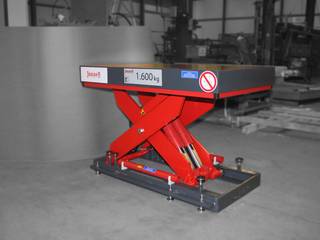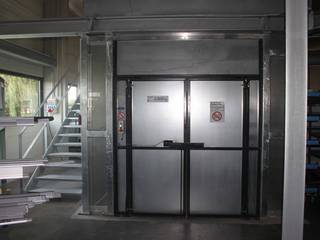Why are scissor lift tables, which are used as simplified goods lifts, more expensive than simple standard lift tables? Why can't you simply use a ready-made lift table for this application?
These are justified questions, especially when considering the price difference between a standard lift table and simplified goods lifts. In this article I would like to briefly explain why and how these lift tables differ ...
Are there differences in the applicable standard?
The short answer to this is no. As long as a scissor lift only stops at two landings, the same European standard (EN 1570-1) applies to standard lifts and simplified goods lifts. Only when more than two landings are stopped at or when people ride along on the lift, other directives and standards must be applied.
Same standard, but different safety measures?
However, despite the same applicable standard, different safety equipment are required. EN 1570-1 distinguishes between a total of eight different scenarios. The following variables influence the necessary safety equipment:
- Is there more than one landing?
- Is the lift platform in a restricted access area?
- Does the operator have a complete view of the hazard area?
- Do operators ride along on the platform?
- Is the lifting height more than 500 mm or more than 1.6 metres?
- Does the lift operate in dead man's mode or automatic mode?
Example 1: A scissor lift table as a lifting work table
We have decided on a lifting work table as the first example of the necessary safety equipment. Lifting work tables are scissor lift tables which are used in production to provide more ergonomic working conditions. In its simplest design, they enable the workpiece to be raised and lowered so that the employee can always work at the height that is most convenient for him.
Accordingly, the worker works directly on the scissor lift table, which also ensures that the employee has an overview of the entire hazard area during lifting and lowering. Furthermore, lifting work tables always operate only in dead man's mode, i.e. the scissor lift table lifts and lowers only as long as the corresponding button on the controls is pressed. As soon as the button is released, the scissor lift table stops.
Installation situation as per EN 1570-1
If we now look at the lifting work table from the point of view of the eight installation scenarios contained in EN 1570-1, the following picture of the possible dangers emerges:
Is there more than one landing?
No, the lifting work table only has one fixed stop, the fully retracted position. All other lifting positions can be flexibly adjusted to suit the respective employee, but there is no fixed transfer position.
Is the lift platform in a restricted access area?
Lifting work tables are usually used in the production processes of industrial companies, i.e. people from outside the company must first gain access to the production area. This can therefore be called a restricted access area.
Does the operator have a complete view of the hazard area?
We have already answered this question in the opening text. Lifting work tables are normally the size of a Euro pallet, so the entire working area of the scissor lift table can be easily seen by an employee. If a larger scissor lift table is used, it is also possible to use an additional release button for two-person operation.
Do operators ride along on the platform?
Lifting work tables are only designed for lifting workpieces, i.e. no operators are lifted along as well.
Is the lifting height more than 500 mm or more than 1.6 metres?
The question about a lifting height greater than 500 mm has to do with the possible risk of falling from the platform or from the top landing. Because people are not allowed to ride along and there is no top landing, a reply to the question about the 500 mm effective stroke is not necessary.
The question about an effective stroke of 1,600 mm is aimed, among other things, at the possible danger of a person getting underneath the scissor lift table. Normally, the lifting work table lifts to a final height of approximately 1,000-1,100 mm, so that an additional barrier is not required here. A barrier may have to be provided when the effective stroke is higher than that.
Does the lift operate in dead man's mode or automatic mode?
As already described, lifting worktables operate in dead man's mode to enable stopping in any intermediate position.
What does this mean for the safety measures?
Due to this installation situation, the requirements for safety equipment on lifting work tables are quite low. In addition to an appropriate mechanical design, only standard safety equipment, such as a foot protection safety edge, a pipe rupture safety valve, maintenance support struts and a low control voltage are required.
P.S. Because installation situations can differ, these requirements can change (e.g. due to an adjacent open stair railing), so that an individual risk assessment must be made for each scissor lift .
Example 2: Scissor lift table as simplified goods lift
Let us now take a look at the installation situation of a classic simplified goods lift in contrast to the lifting work table. By classic we mean a lift that is only used to transport goods between two floors. This means that operators may enter the lift at the landings, but they are not allowed to ride along. The lift moves to the individual floors with the aid of an automatic control system, i.e. the desired floor only needs to be selected and the lift table moves automatically to the desired end position.
Installation situation as per EN 1570-1
Is there more than one landing?
As already mentioned, we assume two landings for our simplified goods lift so that EN 1570-1 can still be applied.
Is the lift platform in a restricted access area?
Our simplified goods lifts are usually used in production areas or warehouses of industrial companies, so we can assume a restricted access area, just as with the lifting work tables.
Does the operator have a complete view of the hazard area?
We provide a control panel at both the top and bottom landings for the goods lift. This unfortunately makes it no longer possible to see the entire hazard area. For example, if the operator is at the top landing, he is not able to see the area below the lifting platform.
Do operators ride along on the platform?
Our freight elevators are exclusively designed to transport goods, so that operators are not allowed to ride along on them.
Is the lifting height more than 500 mm or more than 1.6 metres?
The lifting height for conventional lifts is at least 3 metres.
Does the lift operate in dead man's mode or automatic mode?
To make using of the lift as convenient as possible, the lift runs in automatic mode. After all, nobody wants to stand at the control panel during the entire lifting and lowering process.
What does this mean for the safety measures?
Compared to a lifting work table, there are two major hazards associated with simplified goods lifts which must be eliminated.
For one thing, someone could fall from the top landing. For this reason, an enclosure is required at the top landing and the access door must also be secured electromechanically. After all, the top access door should only open when the platform is in the top position.
Due to the possible risk of falling, higher technical control-related requirements are placed on this solenoid interlock. For example, a solenoid interlock is released by means of a safe (double) query of the top end position. The solenoid interlock itself must also meet certain technical parameters which go beyond the actual fulfilment of its function.
An enclosure is also required at the bottom landing. As already described, the operator cannot see from above whether there is someone at the bottom landing. This enclosure must also have an electromechanically secured access door.
We also apply higher requirements to the hydraulic systems of our simplified goods lifts than would be required as standard. Every simplified goods lift is equipped with electric shut-off valves and lowering brake valves directly on the cylinder. It is directly connected to the cylinder connection, without intermediate pipe segments or hoses. This makes it possible to establish a safe operating condition even in the event of small leaks or a complete hose rupture (see the article on Safety through hydraulic valves).
The second fixed landing also causes another safety problem. After all, the scissor lift table could be overloaded at this position. Such an overload cannot be detected with standard hydraulic lift tables , as these often only have a pressure relief valve, but no pressure sensor. Therefore, the current operating pressure needs to be recorded here and it needs to be compared with the nominal pressure. If the lift table is overloaded, it must of course no longer be possible to move it.
Conclusion
Especially the comparison between a lifting work table and a simplified goods lift shows that not all lift tables are equal. Each installation situation must rather be matched with the applicable standards. Depending on the existing hazard, other safety equipment must therefore also be provided.
If we now compare a standard ready-made lift table with a scissor lift table, which is intended for transporting goods between several levels, the differences in equipment and so in price also becomes clear. For example, the additional fencing, the electromechanical protection of the access doors and the increased demands on the control system lead to higher costs.




Comments (0)
No comments found!